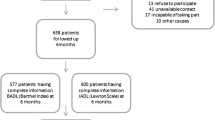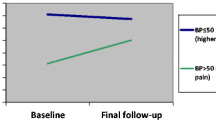Abstract
Summary
Our study identified pre-fracture variables, such as home status or function, that are directly or indirectly associated with frailty status before fracture. The prevention in the deterioration of those variables would improve the prognosis of those hip fractured, being this an important issue for the societies with increasingly aging population.
Introduction
This study was designed to identify predictors of pain and declines in function among elderly patients following a fall-related hip fracture.
Methods
Patients aged 65 or older with a fall-related hip fracture retrospectively completed pre-fracture status questionnaires (T0; n = 740) and were then prospectively followed for 6 months (T1; n = 546). Of these, 474 were randomly selected to complete an additional 18 months of follow-up (T2; n = 356). Primary outcome measures were changes in the pain and function dimensions of the Western Ontario and McMaster Universities Osteoarthritis Index questionnaire’s short form (WOMAC-SF). Potential predictors included sociodemographic variables, in-hospital and clinical pre- and post-fracture data, and activities of daily living at baseline and follow-up. Multivariate logistic regression was used for analysis.
Results
Predictors of worsening pain at T1 and/or T2 included living in a home care situation or nursing home before the fracture (OR at T1, 1.515; OR at T2, 2.749), and low pre-fracture pain (OR at T1, 1.028; OR at T2, 1.027). Predictors of deterioration in function at T1 and/or T2 included age ≥85 years (OR at T1, 2.714; OR at T2, 4.762), lower income (OR at T1, 1.755), high pre-fracture hip function (OR at T1, 1.029; OR at T2, 1.028), referral to rehabilitation upon discharge (OR at T1, 2.378; OR at T2, 2.881), and longer delay between fall and surgery (OR at T1, 1.133; OR at T2, 1.124).
Conclusions
Frailty before hip fracture is a predictor of greater post-fracture pain and deterioration in function. Given that exercise programs help prevent frailty, promoting exercise in elderly may improve the prognosis of hip fracture.


Similar content being viewed by others
References
Frost SA, Nguyen ND, Black DA, Eisman JA, Nguyen TV (2011) Risk factors for in-hospital post-hip fracture mortality. Bone 49:553–558
Flikweert ER, Izaks GJ, Reininga IH, Wendt KW, Stevens M (2013) Evaluation of the effect of a comprehensive multidisciplinary care pathway for hip fractures: design of a controlled study. BMC Musculoskelet Disord 14:291
Haentjens P, Magaziner J, Colon-Emeric CS, Vanderschueren D, Milisen K, Velkeniers B, Boonen S (2010) Meta-analysis: excess mortality after hip fracture among older women and men. Ann Intern Med 152:380–390
Edwards M, Baptiste S, Stratford PW, Law M (2007) Recovery after hip fracture: what can we learn from the Canadian occupational performance measure? Am J Occup Ther 61:335–344
Kristensen MT (2011) Factors affecting functional prognosis of patients with hip fracture. Eur J Phys Rehabil Med 47:257–264
Buecking B, Struewer J, Waldermann A, Horstmann K, Schubert N, Balzer-Geldsetzer M, Dodel R, Bohl K, Ruchholtz S, Bliemel C (2014) What determines health-related quality of life in hip fracture patients at the end of acute care?-a prospective observational study. Osteoporos Int 25:475–484
Rohde G, Haugeberg G, Mengshoel AM, Moun R, Wahl AK (2008) Is global quality of life reduced before fracture in patients with low-energy wrist or hip fracture? A comparison with matched controls. Health Qual LifeOutcomes 6:90–101
Shyu YI, Chen ML, Chen MC, Wu CC, Su JY (2009) Postoperative pain and its impact on quality of life for hip-fractured older people over 12 months after hospital discharge. J Clin Nurs 18:755–764
Lin WP, Wen CJ, Jiang CC, Hou SM, Chen CY, Lin J (2011) Risk factors for hip fracture sites and mortality in older adults. J Trauma 71:191–197
Leibson CL, Tosteson AN, Gabriel SE, Ransom JE, Melton LJ (2002) Mortality, disability, and nursing home use for persons with and without hip fracture: a population-based study. J Am Geriatr Soc 50:1644–1650
Davis AM, Agnidis Z, Badley E, Kiss A, Waddell JP, Gross AE (2006) Predictors of functional outcome two years following revision hip arthroplasty. J Bone Joint Surg Am 88:685–691
Soteriades ES, Evans JC, Larson MG, Chen MH, Chen L, Benjamin EJ, Levy D (2002) Incidence and prognosis of syncope. N Engl J Med 347:878–885
Charlson ME, Pompei P, Ales KL, MacKenzie CR (1987) A new method of classifying prognostic comorbidity in longitudinal studies: development and validation. J Chronic Dis 40:373–383
Bellamy N, Buchanan WW, Goldsmith CH, Campbell J, Stitt LW (1988) Validation study of WOMAC: a health status instrument for measuring clinically important patient relevant outcomes to antirheumatic drug therapy in patients with osteoarthritis of the hip or knee. J Rheumatol 15:1833–1840
Macaulay W, Nellans KW, Garvin KL, Iorio R, Healy WL, Rosenwasser MP (2008) Prospective randomized clinical trial comparing hemiarthroplasty to total hip arthroplasty in the treatment of displaced femoral neck fractures: winner of the Dorr award. J Arthroplasty 23:2–8
Davis AM, Badley EM, Beaton DE, Kopec J, Wright JG, Young NL, Williams JI (2003) Rasch analysis of the western Ontario McMaster (WOMAC) osteoarthritis index: results from community and arthroplasty samples. J Clin Epidemiol 56:1076–1083
Bilbao A, Quintana JM, Escobar A, Las Hayas C, Orive M (2011) Validation of a proposed WOMAC short form for patients with hip osteoarthritis. Health Qual Life Outcomes 9:75–85
Mahoney FI, Barthel DW (1965) Functional evaluation: the Barthel index. Md State Med J 14:61–65
Baztán JJ, Pérez J, Alarcón SC, Izquierdo E, Manzarbeitia J (1993) Indice de Barthel: instrumento válido para la valoración funcional de pacientes con enfermedad cerebrovascular. Rev Esp Geriatr Gerontol 28:32–40
Lawton MP, Brody EM (1969) Assessment of older people: self-maintaining and instrumental activities of daily living. The Gerontologist 9:179–186
Vergara I, Bilbao A, Orive M, Garcia-Gutierrez S, Navarro G, Quintana JM (2012) Validation of the Spanish version of the Lawton IADL scale for its application in elderly people. Health Qual Life Outcomes 10:130
Revicki D, Hays RD, Cella D, Sloan J (2008) Recommended methods for determining responsiveness and minimally important differences for patient-reported outcomes. J Clin Epidemiol 61:102–109
Morrison RS, Magaziner J, McLaughlin MA, Orosz G, Silberzweig SB, Koval KJ, Siu AL (2003) The impact of post-operative pain on outcomes following hip fracture. Pain 103:303–311
Strike SA, Sieber FE, Gottschalk A, Mears SC (2013) Role of fracture and repair type on pain and opioid use after hip fracture in the elderly. Geriatr Orthop Surg Rehabil 4:103–108
Cobo CM (2014) The influence of institutionalization on the perception of autonomy and quality of life in old people. Rev Esc Enferm U S P 48:1013–1019
Yumin ET, Simsek TT, Sertel M, Ozturk A, Yumin M (2011) The effect of functional mobility and balance on health-related quality of life (HRQoL) among elderly people living at home and those living in nursing home. Arch Gerontol Geriatr 52:e180–e184
Borgstrom F, Lekander I, Ivergard M, Strom O, Svedbom A, Alekna V, Bianchi ML, Clark P, Curiel MD, Dimai HP, Jurisson M, Kallikorm R, Lesnyak O, McCloskey E, Nassonov E, Sanders KM, Silverman S, Tamulaitiene M, Thomas T, Tosteson AN, Jonsson B, Kanis JA (2013) The international costs and utilities related to osteoporotic fractures study (ICUROS)—quality of life during the first 4 months after fracture. Osteoporos Int 24:811–823
Fortin PR, Clarke AE, Joseph L, Liang MH, Tanzer M, Ferland D, Phillips C, Partridge AJ, Belisle P, Fossel AH, Mahomed N, Sledge CB, Katz JN (1999) Outcomes of total hip and knee replacement: preoperative functional status predicts outcomes at six months after surgery. Arthritis Rheum 42:1722–1728
Salpakoski A, Tormakangas T, Edgren J, Sihvonen S, Pekkonen M, Heinonen A, Pesola M, Kallinen M, Rantanen T, Sipila S (2014) Walking recovery after a hip fracture: a prospective follow-up study among community-dwelling over 60-year old men and women. Biomed Res Int 2014:289549
National Institute for Health Excellence Care (2011) The management of hip fracture in adults. Royal College of Physicians, UK
Scotish Intercollegiate Guideline Network (SIGN) (2011) Management of hip fracture in older people. Scotish Intercollegiate Guideline Network (SIGN), Edinburgh
Nascimento CM, Ribeiro AQ, Cotta RM, Acurcio FA, Peixoto SV, Priore SE, Franceschini SC (2012) Factors associated with functional ability in Brazilian elderly. Arch Gerontol Geriatr 54:e89–e94
Wylde V, Dieppe P, Hewlett S, Learmonth ID (2007) Total knee replacement: is it really an effective procedure for all? Knee 14:417–423
Lantz PM, House JS, Lepkowski JM, Williams DR, Mero RP, Chen J (1998) Socioeconomic factors, health behaviors, and mortality: results from a nationally representative prospective study of US adults. JAMA 279:1703–1708
Acknowledgments
We gratefully thank the doctors of the Emergency Service and all the interviewers from the participant hospitals (Araba University hospital (Santiago Hospital + Txagorritxu Hospital), Basurto University hospital, Cruces University hospital and Galdakao-Usansolo hospital) for their invaluable collaboration in patient recruitment. We are also grateful to the participants who voluntarily took part in this study, to the Research Committee of the Galdakao-Usansolo Hospital, and to Patrick J. Skerrett for help in editing this report. This work was supported by a grants from the Fondo de Investigación Sanitaria (PI08/90417); Department of Health of the Basque Country (2008111016); Asociación para la promoción de la investigación clínica del hospital de Galdakao-GOSIKER (BIOEF11/033); KRONIKGUNE- Centro de Investigacióin en Cronicidad and the European Regional Development Fund (ERDF). These institutions had no further role in study design; in the collection, analysis and interpretation of data; in the writing of the manuscript; nor in the decision to submit the paper publication.
Conflicts of interest
Miren Orive, Ane Antón, Susana García-Gutiérrez, Carlota Las Hayas, Nerea Gutiérrez, Jon Zabala, and Jose María Quintana declare that they have no conflict of interest.
Author information
Authors and Affiliations
Corresponding author
Electronic supplementary material
Below is the link to the electronic supplementary material.
ESM. 1
(DOC 66 kb)
OFF (Older Falls Fracture)-IRYSS group
OFF (Older Falls Fracture)-IRYSS group
Jose María Quintana Lópeza,k,l, Susana García Gutiérreza,k,l, Carlota Las Hayas Rodríguezb,k,l, Jon Zabala Echenagusiac, Miren Orive Calzadaa,k,l, , Nerea González Hernándeza,k,l , Urko Aguirre Larracoecheaa,k,l, Ane Anton Ladislaoa,k,l, Iratxe Lafuente Guerrero a,k,l , , Amaia Bilbao Gonzálezd,k,l, Luis Angel Sanado Lampreavee, Ignacio Javier Gamilla Iglesiase, Elena Urrutia Sanzberroe, Rocío Fernández Albae, Ana Iribas Garnicae, Elena Urrutia Sanze, Juan Carlos Arenaza Merinof, Lander Larrea Azkorrag, Celestino Gómez Calatravah, Francisco Rivasi, Gemma Navarro Rubioj
a Unidad de investigación. Hospital Galdakao-Usansolo. Galdakao (Bizkaia)
b Departamento de Personalidad, evaluación y tratamiento. Universidad de Deusto. Bilbao (Bizkaia)
c Servicio de traumatología. Hospital Galdakao-Usansolo. Galdakao (Bizkaia)
Universidad del País Vasco (UPV). Leioa (Bizkaia)
d Unidad de investigación. Hospital Universitario Basurto. Basurto (Bizkaia)
e Servicio de traumatología. Hospital Universitario Araba. Vitoria-Gasteiz (Araba)
f Servicio de traumatología. Hospital Universitario Basurto (Bizkaia)
g Servicio de traumatología. Hospital Universitario Cruces. Barakaldo (Bizkaia)
h Servicio de traumatología. Hospital Universitario Donostia. San Sebastián-Donostia (Gipuzkoa)
i Unidad de epidemiología. Hospital Costa del Sol. Marbella (Málaga)
j Unidad de epidemiología. Corporació Parc Tauli Clinic. Sabadell (Barcelona)
k Red de Investigación en Servicios de Salud en Enfermedades Crónicas-REDISSEC
l Centro de investigación en Cronicidad (Kronikgune). Bilbao (Bizkaia)
Rights and permissions
About this article
Cite this article
Orive, M., Anton-Ladislao, A., García-Gutiérrez, S. et al. Prospective study of predictive factors of changes in pain and hip function after hip fracture among the elderly. Osteoporos Int 27, 527–536 (2016). https://doi.org/10.1007/s00198-015-3267-y
Received:
Accepted:
Published:
Issue Date:
DOI: https://doi.org/10.1007/s00198-015-3267-y




